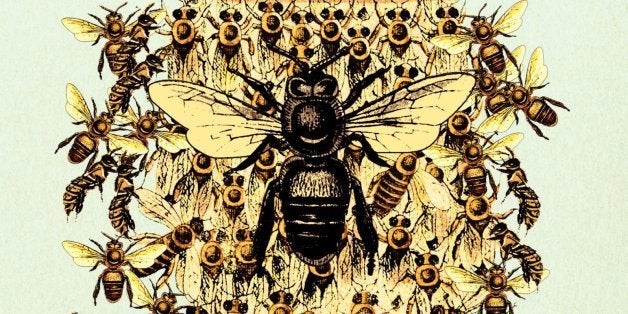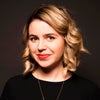
The Bees
by Laline Paull
Ecco, $25.99
Publishes May 6, 2014
The Book We're Talking About is a weekly review combining plot description and analysis with fun tidbits about the book.
What we think
Bees have been enjoying a popularity boom in recent years. Not only do we love their honey and their cheerfully striped coats, but we’re increasingly aware of the vital role they play in producing the crops we depend on for food. In the past several years, more and more studies have raised the alarm about the declining global bee population and the grim implications this will have for human survival. Accordingly, Laline Paull’s debut novel exploring the life of a honey bee navigating the age of pesticides and suburban sprawl seems well-timed.
The Bees takes us fully into the world of a honey bee hive, playfully anthropomorphizing the insects while still capturing the bizarre habits, rituals and castes unique to the bee. Paull reimagines the queen-centric society of the bees as a devoutly religious colony that treats their queen as a god. Life is ordered by the scents that convey the queen’s love and hive vibrations that allots tasks for each bee to carry out daily -– and, of course, by the strict caste system that assigns different categories of worker to specific functions in the hive.
The novel follows worker bee Flora 717, a sanitation bee, as she navigates the repressed, labyrinthine politics of the hive. Times are tough for the hive, and despite being a member of the lowest social caste, and a deformed one at that, Flora has unique abilities that bring her to the attention of the ruling caste of the bees. Flora’s strength and quick wits propel her to the prestigious role of forager, and she soon seems essential to the survival of the hive. Mysterious gray dust from the fields has been killing foragers in droves, and fewer and fewer healthy flowers can be found within flying distance, but Flora has the toughness and smarts to escape danger and find food for her sisters. But her canniness and brawn -– and the traitorous secret she's hiding -– may also undermine the ruling order of the hive, and it soon seems her bold individualism could imperil the hive she loves so much.
Paull’s extensive research into the species makes for fascinating reading on the naturalist level. The book is most engrossing when bringing to life the intriguing functions of a beehive, from the feeding of royal jelly to the larvae to the dances by which foraging bees direct each other to fertile grounds for gathering nectar and pollen.
On the plot level, however, the novel stumbles. The book struggles to maintain urgency as it juggles narrative strands -– the question of the queen’s possibly waning fertility; the mysterious substance, presumably a pesticide, that has been killing foragers; Flora’s own maternal ambitions; her unlikely friendship with a drone -– most of which are never satisfactorily realized or resolved. Paull frequently resorts to credulity-straining shortcuts and evasions to keep the plot advancing -– and to keep her rule-shattering heroine alive in a violently repressive hive. Ultimately, the stakes of the novel seem disappointingly small, as broad environmental issues are tantalizingly hinted at but never confronted. Like several other strains of the plot, these unsettling signs of ecosystem destruction are underdeveloped, and finally dropped.
The plot’s awkward pacing and underdevelopment weaken Paull’s debut, and it’s difficult not to wish for a more bold examination of the effects of development and pesticide use on honey bee colonies. However, Paull’s clear fascination with her source material brings humanity and warmth to a depiction of the remarkable social world of bees, which is no small achievement in itself.
What other reviewers think
Los Angeles Times: "Flora is somewhere in the middle, a bee with a burgeoning consciousness.... A move like that is perhaps inevitable in a novel such as this one; Paull is not writing about real bees, after all. At the same time, it weakens the central conceit (and what is best about the book), which is its understanding that the bees have nothing to do with us."
Kirkus: "It's clear that Paull is using the hive as an analogy for a class-bound society, where variation is punished, but this kind of dystopian vision can only thrive when the associations to contemporary circumstances are unambiguous. Much is muddled here, primarily the reader’s connection to the heroine, who rarely transcends being a bee."
Who wrote it?
The Bees is Laline Paull’s first novel. She has written a number of plays, including two that were performed at the Royal National Theatre in London. She studied English at Oxford and theater in London, in addition to studying screenwriting in Los Angeles and working as a screenwriter.
Who will read it?
Fans of dystopian science fiction and fantasy. Also, readers fascinated by fiction focused on the natural world.
Opening lines:
“The old orchard stood besieged. To one side spread a vast, arable plain, a dullard’s patchwork of corn and soy reaching to the dark line of the hills. To the other, a light-industrial development stretched toward the town.”
Notable passage:
“Beyond the great dull fields of wheat and soy, a vast golden plain of rapeseed radiated in the distance, the oily-sweet smell of its nectar rising warm and seductive on the air. Flora locked onto it and as she flew nearer saw and smelled enough nectar and pollen to fill every chalice in the Fanning Hall, stack the walls of the Treasury with honey, and make bread to fill the hungriest mouths.”
Rating, out of ten:
6. Paull’s depth of research into the hive culture shines through, but the uneven pacing and underdeveloped plot make for a less-than-thrilling read.
Read an excerpt of The Bees:
